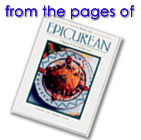
 |
|||||
|
|
|
|
|
|
|

American cooks are stuck in a rut. They can't seem to help themselves-if its not standard meat and
potatoes, then its pasta and pizza. Gourmet home cooks sometimes emulate the French. But that's about
as far as it goes.
To get out of your rut and enliven your next party, why not try something exotic like Moroccan? Kitty Morse,
who was born and raised in Casablanca gives us a firm grounding in Moroccan cuisine in her book,
Cooking at the Kasbah. The recipes, though new to most of us, are not impossible
to recreate with authenticity.
Like other Mediterranean countries, Morocco uses such staples as fava beans, chicken, lamb, beef and fish.
But instead of spaghetti, Moroccan's favor smaller pasta like couscous, vermicelli and orzo. And unlike other
Mediterranean countries, Morocco uses a liberal number of spices such as saffron, turmeric, ginger, cinnamon,
cumin and paprika to flavor many of the dishes.
For ingredients unique to Moroccan cooking and hard to find in the U.S., Morse gives us basic recipes to make
our own preserved lemons, aged butter, North African hot sauce, and Moroccan spice blend. Most of the 70
recipes in the book, however, do not require impossible to acquire ingredients.
There are sections on appetizers, soups, salads, savory pastries and breads, Moroccan stew (tagine),
couscous, desserts, and even beverages, such as sweet almond milk; fresh pomegranate and orange juice.
In a country that has very few cookbooks, recipes are traditionally passed on orally from one generation to
another. Morse has adapted recipes from family and friends, from Berber peasants and from fine restaurants in
Marrakesh and Fez, to make them accessible to the American cook. "I simplified and lightened when possible,"
says Morse, "taking great care to preserve the essence of the original dish."
The book is a feast for the eyes, with sumptuous food photography by Laurie Smith that accompanies most
recipes, and atmospheric street photographs by the author's husband. Morse also adds to the atmosphere in a
fascinating text about the history of Moroccan culture, cuisine, and customs surrounding the open-air market,
the table and the art of eating with three fingers.
Cooking at the Kasbah is an interesting armchair visit to an exotic land,
and while you may never make the trip to Morocco, Morse's instructions will allow you to recreate the experience
in your own home for the pleasure of your family and friends. |
| Copyright © 2005 Epicurean.com & Fezziwig Publishing Co. All rights reserved |